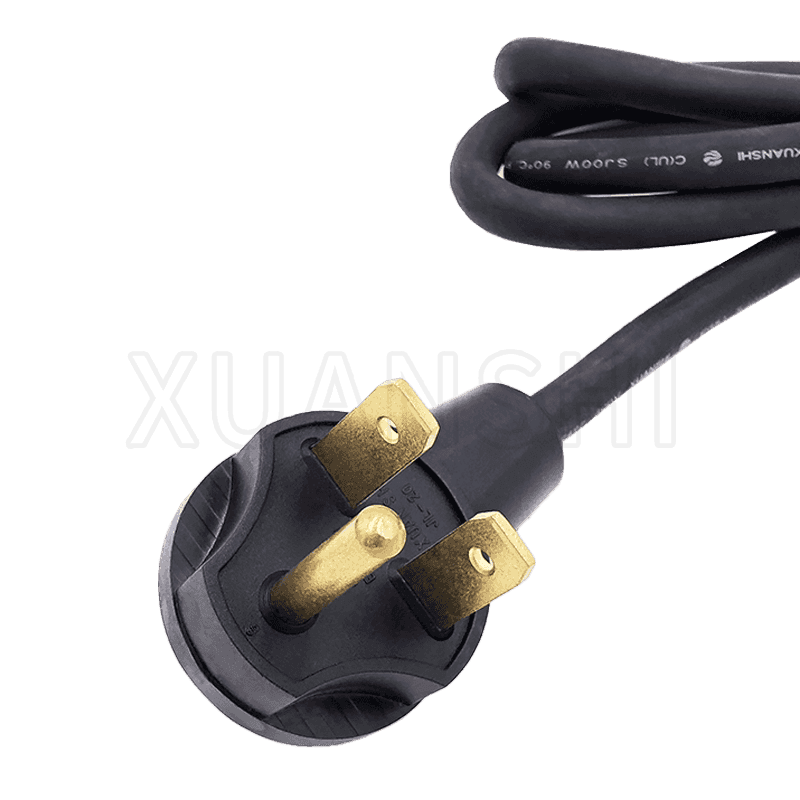To make power cords resistant to environmental factors such as moisture and heat, several design considerations and manufacturing techniques can be employed:
1.Selection of Materials:
Silicone Rubber: Silicone rubber is highly resistant to moisture, heat, and UV exposure. It maintains flexibility across a wide temperature range, making it suitable for diverse environments.
Neoprene: Neoprene, a synthetic rubber, offers excellent resistance to heat, ozone, and oil. It is commonly used in industrial applications where exposure to harsh conditions is expected.
Thermoplastic Elastomers (TPE): TPE compounds provide a balance of flexibility and durability. They resist moisture and remain pliable even at low temperatures, making them ideal for outdoor and cold weather applications.
2.Insulation and Jacketing:
Cross-Linked Polyethylene (XLPE): XLPE insulation offers superior thermal stability and electrical properties. It resists moisture penetration and maintains its dielectric strength, ensuring safe and efficient power transmission.
Multiple Layers: Applying multiple layers of insulation and jacketing provides an added barrier against environmental factors. Each layer serves a specific purpose, enhancing the overall resilience of the power cord.
3.Sealing Techniques:
Over-Molding: Over-molding is a process where a seamless, watertight layer is molded over connectors and joints. This technique prevents moisture ingress, ensuring the integrity of the internal components.
Compression Seals: Compression seals are used in conjunction with specialized grommets to seal entry points effectively. They provide a secure seal while allowing flexibility in cable movement.
4.Moisture-Resistant Coatings:
Nano-Coatings: Nano-coatings create a microscopic layer on the surface of the power cord, repelling water and preventing it from permeating the cable structure. These coatings are highly effective in humid or wet environments.
5.Heat-Resistant Additives:
Fillers: Incorporating heat-resistant fillers, such as mica or ceramic materials, enhances the cable's thermal stability. These fillers dissipate heat, reducing the risk of overheating and ensuring the cable's performance under high-temperature conditions.
6.Armor or Braiding:
Metal Armor: Metal armor, such as steel or aluminum, provides robust mechanical protection. It shields the cable from physical damage and enhances resistance to environmental hazards, including moisture and heat.
Braiding: Braided shielding, made of materials like tinned copper, offers electromagnetic interference (EMI) protection. Additionally, it adds a layer of protection against mechanical stress and environmental factors.
7.IP Rating:
Ingress Protection (IP) Rating: IP ratings, defined by international standards (e.g., IP67, IP68), specify the level of protection against solids and liquids. Higher IP ratings indicate superior resistance to moisture and dust, ensuring the power cord's reliability in challenging conditions.
8.Thermal Insulation:
Thermal Barrier Layers: Integrate thermal barrier layers within the power cord to minimize heat transfer. These layers insulate the cable, ensuring it remains operational even when exposed to elevated temperatures.
9.Proper Strain Relief:
Strain Relief Designs: Implement strain relief features, such as molded bends and cable glands, near connectors. These designs prevent sharp bends, which can lead to insulation damage, ensuring the cable's longevity under mechanical stress.
A NEMA 6-30P plug power cord with a type JL-20 connector is a type of electrical cord used to provide power to appliances or other devices in North America. The "6-30" part of the code refers to the type of connector used on the plug.This type of connector has two flat parallel blades and a grounding pin, and is used for appliances and other devices that operate at a voltage of 240V and a current of 30 amps.
